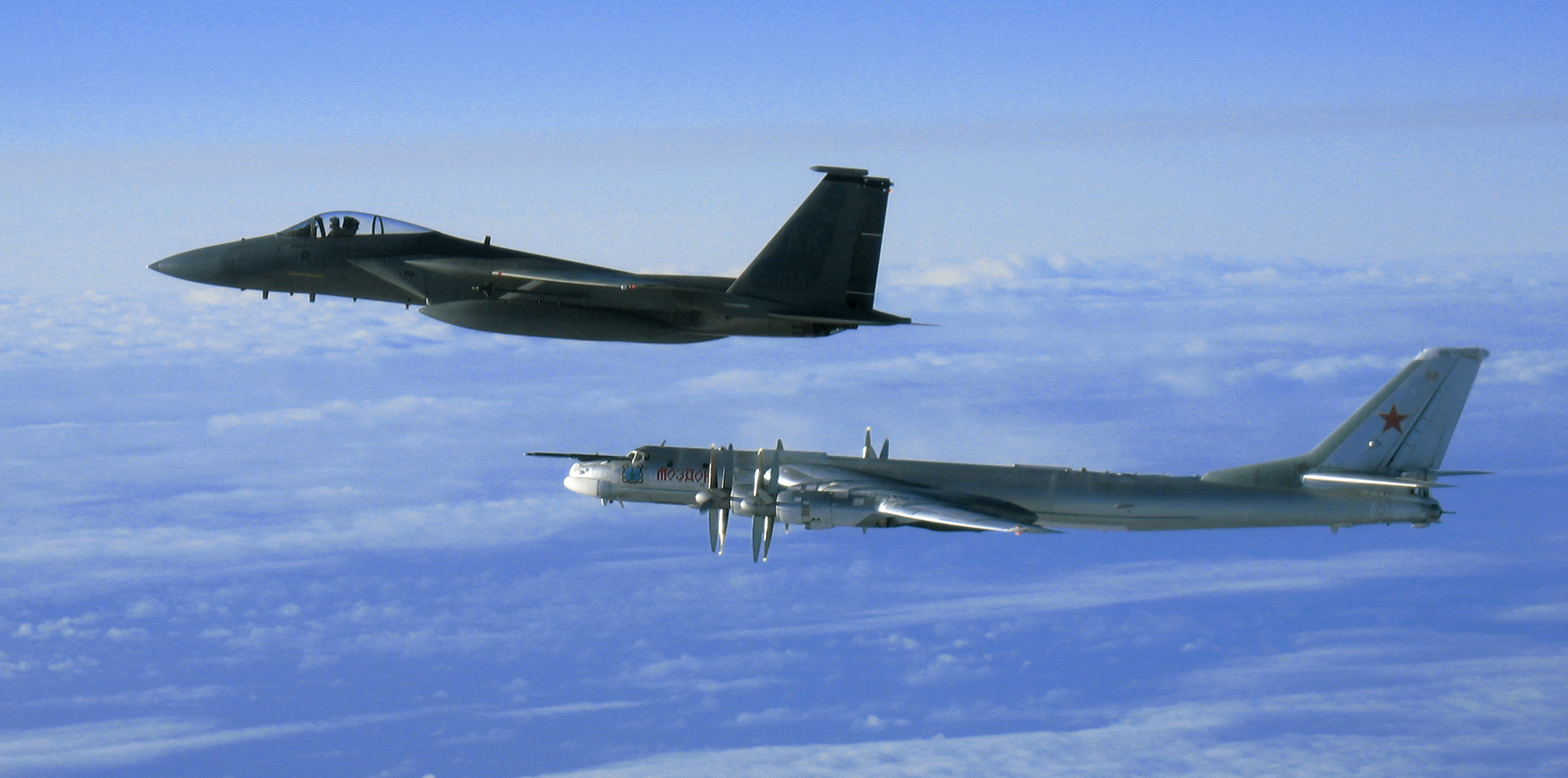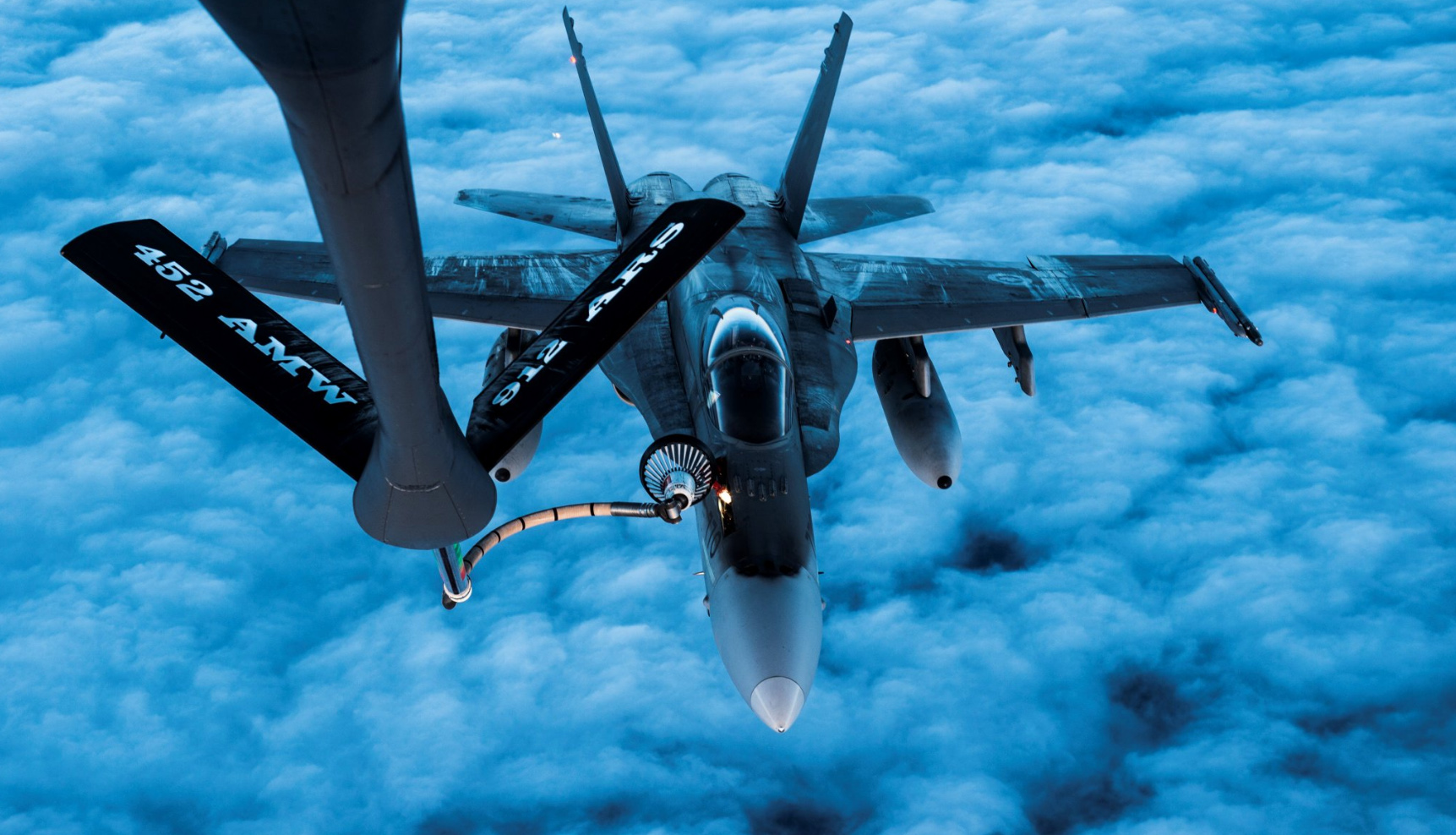
A U.S. Air Force F-15 Eagle flies next to a Russian Tu-95 near the west coast of Alaska. [U.S. Air Force]
But in all the years that Soviet and, later, Russian aircraft have embarked on such missions, they’ve never breached Canadian or American airspace, said Major Jennifer Stadnyk, a spokeswoman at North American Aerospace Defence Command (Norad) headquarters in Colorado.
Like territorial waters, the sovereign airspace of Canada and the United States extends just 12 nautical miles from the coast. And like maritime economic zones, their air defence identification zones extend 200 nautical miles.
Civilian aircraft must identify themselves before entering air defence identification zones, but not state-owned aircraft. Norad is responsible for identifying and monitoring all aircraft approaching North America.
The Russian missions are believed to be intended to gauge North American response and the encounters are usually congenial.
Commissioned as the Cold War escalated in 1956, the Tupolev Tu-95 Bear bombers usually travel in flights of two or more, said Stadnyk. The Russians made four approaches the week of April 17, at least once travelling west to east across the top of Alaska and the Canadian Arctic.
On May 1, two Russian bombers, flanked by two fighter jets with intercepted a U.S. F-22 aircraft off the coast of Alaska. At one point they were as close as 50 miles from Point Hope, Alaska. This followed two other incidents in April.
Russia “regularly carries out patrol missions above the neutral waters of the Arctic, the Atlantic, the Black Sea and the Pacific Ocean,” the Russian defence ministry said in a written statement.
“All such missions are carried out in strict compliance with international regulations and with respect to national borders.”
The turboprop Bears were flying in the air defence identification zone, confirmed Stadnyk, and remained in international air space at all times.
“Every incident was conducted, by both Russia and Norad fighters, in a safe and professional manner,” said Stadnyk. “There was no provocation or anything like that. Sometimes they might wave; sometimes they might communicate on radio.”
The last intercept before this flurry of activity by Russian long-range aviation came 39 nautical miles off the California coast on July 4, 2015. Canadian fighters had not intercepted Russian aircraft since Dec. 8, 2014.
Norad aircraft have intercepted and visually identified Russian aircraft off North America about 60 times since 2007, for an average of about seven times annually. The numbers have varied each year from as high as 15 to as low as none.
Stadnyk said the lack of intercepts last year can be attributed to several factors, including a known operational stand-down of the Tu-95 fleet.
“We haven’t seen this level of activity recently [but] it’s not unprecedented,” she said. “What they’ve been doing now is very similar to what we have seen them do in 2012, 2013, 2014.
“During the Cold War, it was pretty much a regular occurrence. Then after the Cold War, it died down for a while. In 2007, Russia resumed their long-range aviation activity.”

A U.S. Air Force KC-135 refuelling a RCAF CF-18. [NORAD & USNORTHCOM]
The Americans conduct similar missions near Russia and China but Canada has no long-range bombers. Stadnyk said most state-owned aircraft crossing into American and Canadian air defence identification zones are Russian. She wouldn’t comment on the nationalities of others.
The approaches come as tensions between Moscow and the West are at the highest they have been in decades. Russian forces have massed west of Moscow as the North Atlantic Treaty Organization prepares to mount security missions in Baltic states.
Russia deployed ground-launched cruise missiles at two locations inside Russia in December—a violation, the Americans say, of a 1987 treaty prohibiting ground-launched intermediate-range missiles. Russian fighters have buzzed U.S. naval vessels on several occasions in the past year, coming within 10 metres of the USS Donald in the Baltic Sea in April 2016.
A Russian spy ship, the SSV-175 Viktor Leonov, made several protracted appearances off the U.S. coast after President Donald Trump’s inauguration this year, its first appearance near the U.S. in two years.
In a bizarre twist, given the current climate, the Russians recently conducted a five-day aerial surveillance mission across Canada. Accompanied by Canadian observers, the Russians photographed and documented the country’s military infrastructure.
The mission was authorized by the Treaty on Open Skies, signed by the U.S., Russia, Canada and 31 other countries in 1992. Enacted in 2002, it allows members to inspect each other’s military capabilities and activities in the interests of mutual trust. Canada conducted a similar mission across Russia in November.
Advertisement





















